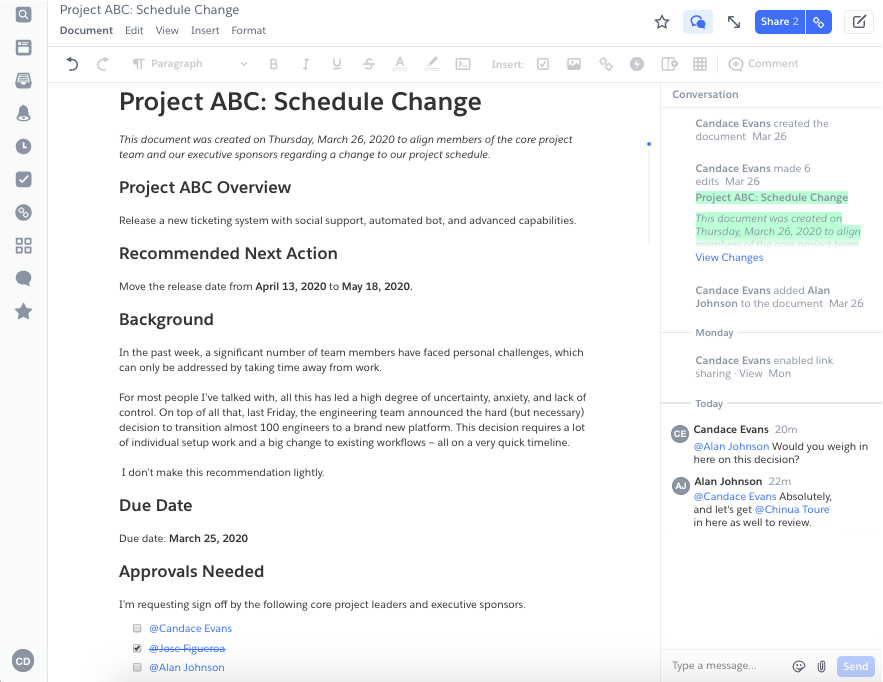Discover New Ways to Do Old Things
Learning Objectives
After completing this unit, you’ll be able to:
- Make use of collaboration tools to get work done.
- Digitally transform your previous work routines.
Work in New Ways
In 2020 and into 2021, people all over the world had to adapt to working in different ways because of the COVID-19 pandemic. At that time, many of us were all virtual, all the time. Today, many employees remain fully remote, and many businesses allow hybrid work (some days remote, some days in the office). This module is meant to give you actionable productivity tips and guidance that apply whether you work remotely, keep a hybrid schedule, or are in the office 5 days a week.
Specifically, you’ll learn:
- How to adapt and transform your work patterns and practices.
- How to stay productive with modern time management.
- How to use your calendar to boost your productivity.
Let’s start with the way work gets done and decisions get made—meetings.
Make the Most of Your Meetings
Whether you’re meeting in person or via video, adhering to meeting best practices makes all of your meetings more productive. Here are tips to help you (and your team) prepare for meetings, run meetings, and follow-up.
Before the Meeting
| Set the agenda. | Add the agenda to the meeting invite in advance. Add durations and owners for each item on the agenda. |
|---|---|
|
Send a read-ahead document. |
Get everyone aligned by preparing a document in advance that aligns everyone around the goals of the meeting, desired outcomes, obstacles, and necessary background information. |
|
Consider participants’ time zones. |
Make sure you’re scheduling at a time when all of your required attendees can attend without having to wake up at 2 AM. |
During the Meeting
| Establish clear roles. | Name a moderator, timekeeper, and notetaker at the start of your meeting. When you’re in a room together, these roles may naturally fall in place as people gather around the table. With a virtual meeting, you must be intentional about assigning these roles at the outset. |
|---|---|
|
Use cloud-based document tools for notes. |
Add everyone in the meeting to the notes document and encourage them to contribute during the call. |
|
Avoid side conversations and interruptions. |
During hybird meetings, virtual attendees feel excluded when they can’t hear in-room conversations. And during all-virtual meetings, when two people speak at once, no one can hear what either are saying. Practice active listening and encourage everyone to do the same. |
After the Meeting
| Send a recap. | Share your notes document with everyone, and highlight important decisions made and next steps. |
|---|---|
|
Schedule a follow-up. |
If there was an action to have a follow-up call, schedule it right away. |
Introducing this additional discipline around your meetings makes them more effective in general, and increases productivity across your company.

Reduce Meetings Altogether
Why not forgo the meeting altogether by working asynchronously using Quip? Quip is a mobile-friendly, cloud-based document collaboration tool. You can create and share documents and spreadsheets, spin up project plans, and assign tasks, all in one place. Every Quip document has built-in chat, so the conversation you were going to have in a meeting can now be done directly alongside the work.
Quip allows editing by multiple people at the same time, and it has deep integrations to the Salesforce platform. One of the ways we use Quip here at Salesforce is to draft, review, and approve communications.
For example, let’s say we need to announce a schedule change in the rollout of a new tool or process. We could have a meeting with all 15 stakeholders. But instead, we can create a Quip document to drive the change process.

The Quip document contains:
- Short description of the project
- Detailed explanation of why the schedule must change
- Clear action item for each stakeholder
- Due date
- Stakeholder signoff checklist
The project manager invites the project team into the Quip document, where they collaborate on the schedule change and sign off. After all stakeholders sign off, the project manager posts the announcement in Slack. No meeting necessary!
Take Your Collaboration Online
It’s not always neccesary—or the best use of time and resources—to meet in person with your colleagues and customers. Instead, embrace virtual collaboration using Slack, Quip, email, and instant messaging apps. And of course, using your mobile phone.
Try out these methods for getting in touch.
- Schedule 1:1 virtual meetings with customers, colleagues, your employees, or your manager.
- Organize group collaboration chats with your colleagues to share best practices and advice.
- Connect with your employees via video chat, video calls, or Slack huddles.
- Start a Slack channel for online collaboration with groups of colleagues or your customers.
- Invite your customers to collaborate in a cloud-based document you’ve prepared.
- Host a virtual meeting for all of your customers to share best practices among the group.
These are just a few ways you can transform the way you get work done and boost your productivity, using tools like Slack, Quip, and your smartphone. Up next, discover strategies for managing your time.